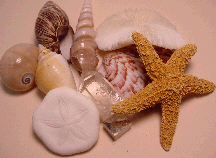BACKGROUND:
 |
| Discover the symmetry of nature by
looking at specimens of sea cookie, sea star, 4 types of snails,
pyrite, mushroom coral, quartz, and scallop |
Symmetry is present in nature. Symmetry can be considered
as an “overall” descriptive term or having an exact correspondence of form
on opposite sides of a dividing line or point. Humans and most vertebrates are
bilaterally symmetrical or one side looks like the other if you image a plane
down the center. All echinoderms have a 5 part pentagonal
symmetry
It is important to distinguish the overall symmetry and
not confuse the surface patterns. Organisms sometimes have different patterns on different parts of their
body. The picture of the Dalmatian above is bilaterally symmetrical
and there is no pattern of the “dots.”
PROCEDURE:
- Review the meaning of symmetry. Symmetry refers to
the overall design and looking for similarities across a line or point.
- In this lab, students will try to
discover different symmetries by observing different natural things.
At each of the 10 stations, students observe
the materials and first decide if the specimen has a particular symmetry. Then
they may want to comment if they see some other kind of pattern.
- Set up the following stations and have students
rotate around to try and discover whether it is radial, cubic, pentagonal,
hexagonal or bilateral symmetry. Some of the materials are in the
kit, but others can be easily found to create that station.
- Bubbles: Set out some liquid dish
detergent and a straw. Students should slightly dip the straw in
the liquid and blow. Bubbles have radial symmetry.
- Sea cookie and sea star (in kit):
All of these organisms have pentagonal
symmetry (5 part). Students may see a pattern of very fine holes throughout the
skeleton of the organisms.
- Mushroom coral (in kit): This
type of coral is solitary, meaning that this one specimen represents one
anima. Many corals are colonial and live in large
groups. This coral has radial symmetry.
- Snail shells (in kit): These marine
snails do not have any symmetry, but it has a coiled or spiral pattern.
This observation might be hard for students, but noticing the spiral pattern
is important. The pattern is different than a whorl which is coiled
on the same plane; a spiral is off centered like a staircase.
- Pyrite (in kit): This mineral has a
"cubic" symmetry. The symmetry can not be determined easily, because
it is not continuous. This is difficult to see unless you have a
very good specimen.
- Leaf (in kit): Collect a few leaves
from outside. If your classroom has a live plant, it may also be
used. Have students look at the veins in the leaves. Many have
bilateral symmetry as well as a pattern of veins (dendritic).
- Quartz (in kit): Has a hexagonal symmetry
if the crystal is complete.
- Scallop (in kit): Please note
that this is only half of the entire bivalve and it has bilateral symmetry. The
pattern reflects ridges and spines.
- Slice of Tree: Notice that
it has not perfect radial symmetry. The rings make up its pattern.
|